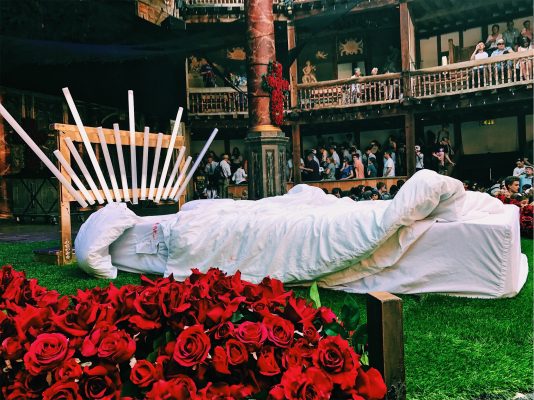Violent Delights, Violent Ends: “Romeo and Juliet” at The Globe
July 4, 2017
Before attending a production at the Globe Theatre, especially one as famed as William Shakespeare’s “Romeo and Juliet,” I expected a certain level of traditionalism; after all, the stated practice of Shakespeare’s Globe is to preserve Shakespeare’s works, producing shows that resemble the original productions as closely as possible. Updated costumes, unexpected casting and fresh staging are allowable in moderation, but any severe alterations are considered blasphemous by the die-hard Shakespeare fans who visit the Globe. This season’s production of “Romeo and Juliet” incorporates innumerable shocking and modern elements into the performance, and many critics reviewed it poorly—one from The Guardian even went so far as to remark that it “vandalizes Shakespeare.” All of the eccentricities that reviewers railed against, the modern elements that included updated lighting and sound technologies, so scandalized the Globe that its executives chose to fire their current Artistic Director, Emma Rice, after only two seasons.
For me, Rice’s creative innovations were the very features that made me so enraptured with the performance. So to those critics, I say kindly, this is the 21st century. Step into the strobe lights and let yourselves appreciate this production’s off-kilter brilliance.
From casual and contemporary costuming to surprising incorporations of music, each element leaves you wondering what will happen next—even though, to some degree, you already know. It is Shakespeare, after all.
When the show began, I was slightly alarmed by the scene that was unfolding. Shrouded figures pushed hospital gurneys onstage, carrying both Romeo and Juliet’s mothers, who then proceeded to birth coffins. Before long, the music’s bass dropped, and all of the characters began dancing feverishly onstage. My wariness persisted as Mercutio and Benvolio entered the scene, but as soon as Romeo entered, face painted like a sad clown and dressed in a casual emo style (complete with a black slouch beanie that I couldn’t stop laughing about), I was able to ground myself in the contemporary aesthetics of this production’s world.
Each actor’s performance was highly engaging, and the two actors playing Romeo and Juliet did a phenomenal job portraying the inadvertent idiocy and angsty-ness of adolescence. (I say this, of course, as someone who is barely 21 and has yet to outgrow these qualities herself). Kirsty Bushell successfully blended well-off Only Child Syndrome and youthful naiveté to create a Juliet who is at once both pointedly strong-willed and lost in a hopeful romanticism. It is the combination of these qualities that makes Juliet’s fervent refusal to marry Paris so compelling to watch.
Romeo, while obviously (and necessarily) having his serious and angst-laden moments, provided more comic relief than I anticipated. Several times throughout the production, Edward Hogg’s Romeo subtlely hid himself in the throng of groundlings crowded around the stage. He would then unexpectedly shout his lines, and those who hadn’t noticed him nearby would startle. Hogg also took opportunities to acknowledge and interact with the audience, at one point referring to the crowd he was weaving through as “good, sweaty trees”—an accurate description considering the intense heat on the day of that particular performance. For another scene, Romeo repositioned a friend of mine to shield him “under the cloak of night,” and she was deeply thrilled at being cast as “the cloak.”
An interesting choice, and one of the most ingenious features of this production, was the overlapping of emotionally conflicting scenes. One instance in particular that stuck with me was Tybalt’s murder scene juxtaposed with Juliet waiting for Romeo in her chamber. Though the scenes themselves took place in different parts of Verona, they were played out simultaneously, and in the same stage space. Because of the overlap, Juliet is sitting happily on her bed when Tybalt is murdered, and she continues to daydream about Romeo even as Tybalt’s body drops onto her mattress, wholly unaware of what’s transpired “elsewhere.” The contrast between Juliet’s giddy anticipation and the brutality of the murder was striking, to say the least.
This production, like any other, had its faults. The opening spectacle of the Capulet ball was a bit much for me; I could’ve done without the visual of Shakespearean characters (dressed in Halloween costumes ranging from a T-Rex to the Wicked Witch of the West) enthusiastically singing and dancing to the Village People. But while I personally could never condone any rendition of “YMCA,” professional or otherwise, I can still understand its function in a production such as this one—to exemplify the frivolity and absurdity of the Capulet household. (I can’t condone it, but I also can’t lie and say I wasn’t utterly entertained by it). In truth, I found that most of the contentious details of this production did serve a purpose, even if that purpose was simply to increase the entertainment level.
For all its absurdities and allegedly controversial choices, there were still moments that brought several audience members, including my classmates, to tears. Watching Romeo and Juliet playfully (yet earnestly) chase each other around the ballroom, dancing together and so suddenly enamored with each other, was more moving than I thought it’d be. The scene was certainly heightened by their matching Day of the Dead catrina (skeleton) costumes, and the remix of Dinah Washington’s “This Bitter Earth” and Max Richter’s “On the Nature of Daylight” playing loudly overhead washed the moment in new, overwhelming emotion. The same sort of tenderness could be found later in the play, in the moments the two spent lying together in Juliet’s bed, denying that morning had broke, their future together uncertain.
Moments like these, for me, are evidence of an emotional tenderness that cannot be lost, no matter the alleged eccentricities—if anything, the updated elements of this production heightened its sentimentality. The timelessness of Romeo and Juliet’s tragedy, and love, remains; modernizing the execution of the show, despite what some may think, could never tarnish that.










